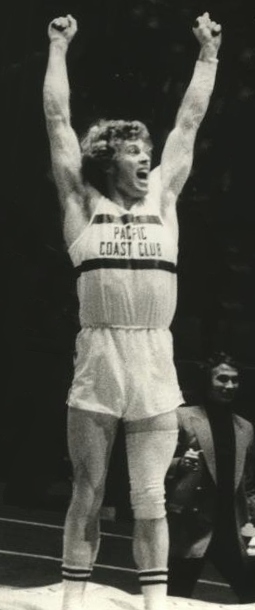Steve Smith (pole vaulter) facts for kids

Smith in 1973
|
|
| Personal information | |
|---|---|
| Birth name | Stephen Norwood Smith |
| Nationality | American |
| Born | November 24, 1951 Long Beach, California, U.S. |
| Died | September 23, 2020 (aged 68) |
| Residence | San Clemente, California, U.S. |
| Height | 6 ft 1 in (1.85 m) |
| Weight | 181 lb (82 kg) |
| Sport | |
| Sport | Track and Field |
| Event(s) | Pole vault |
| Club | Pacific Coast Club |
| Achievements and titles | |
| Personal best(s) | 5.61 m (18 ft 5 in) (1975) |
Stephen Norwood Smith (born November 24, 1951 – died September 23, 2020) was an amazing American pole vaulter. He was an Olympian and the first person ever to jump over 18 feet indoors! In 1973, he was ranked the best pole vaulter in the whole world.
Contents
Steve Smith's Athletic Journey
Steve Smith was the US indoor pole vault champion in both 1972 and 1973. He made history in 1973 by being the first pole vaulter to clear 18 feet indoors!
He qualified for the 1972 Olympics in Munich, Germany. Sadly, he didn't make it to the final round. At the US Olympic trials, Steve came in second. The winner, Bob Seagren, even set a new world record!
At the Olympics, something unfair happened. The main sports group, the IAAF, suddenly banned the special, lighter poles that vaulters like Steve had been using. This ban happened right before the competition. Steve was very upset and finished 18th. He was so frustrated that he threw his pole away!
Breaking Records
After the Olympics, Steve worked even harder at pole vaulting. On January 20, 1973, he broke the indoor world record! He jumped 17 ft 11 in (5.46 m). This beat the old record held by Kjell Isaksson. Just six days later, he jumped even higher, clearing 18 ft 0.25 in (5.49 m).
Steve kept breaking his own records over the next two years. His best jump was 5.61 m (18 ft 5 in) on May 28, 1975, in New York City.
Rivalry with Bob Seagren
Steve had a long-standing rivalry with another American pole vaulter, Bob Seagren. This competition became very public and even a bit personal!
Their rivalry was used to promote a new professional track and field tour called the International Track Association (ITA). Both Steve and Bob joined this tour. After the ITA ended in 1976, Steve wanted to become an amateur athlete again. He was allowed to compete as an amateur in 1979.
He even took legal action to try and compete in the Olympic Trials for the 1980 Moscow Olympics. He finished fourth at the trials. This meant he was an alternate if one of the top three couldn't go. However, the United States boycotted the Moscow Olympics, so his alternate status didn't matter.
Steve retired from athletics in 1983. This was after he hurt his ankle in a car accident. Steve was a natural showman and very popular with the fans. People loved his strong build, his passion for surfing, and his cool style. He was famous for competing in bright cranberry-colored ski pants!
Steve Smith's Early Life
Steve Smith went to South Torrance High School. In 1968, he won the CIF California State Meet championship. He beat the son of the famous Olympic pole vault champion, Bob Richards.
He first went to the University of Southern California. This was the same year his rival, Bob Seagren, graduated. After one year, Steve moved to Long Beach State. At Long Beach State, he wasn't allowed to train with his coach, Dick Tomlinson. So, he ended up training with the Pacific Coast Club instead.
Steve Smith's Later Life
After retiring from sports, Steve Smith became a real-estate agent in southern California.
World Rankings
Experts at Track and Field News ranked Steve Smith among the best pole vaulters in the USA and the world. He was ranked early in his career and again when he returned to amateur competition. He would have been ranked during his professional career too, if the rankings had included professional athletes at that time.
| Year | World rank | US rank |
|---|---|---|
| 1969 | – | 8th |
| 1971 | – | 4th |
| 1972 | 6th | 4th |
| 1973 | 1st | 1st |
| 1980 | – | 8th |
Awards and Honors
In 2012, Steve Smith was honored by being added to the United States National Pole Vault Hall of Fame.
See also
Men's pole vault indoor world record progression

